Japan is a place like no other. Some of the species of sharks there can only be found in Japanese waters. That can be pretty scary if the species is also endangered or in decline. Let’s discover some of the amazing sharks from this part of the world. Some are worldly sea travelers, whereas others you might not know even exist!
1. Japanese Wobbegong (Orectolobus japonicus)
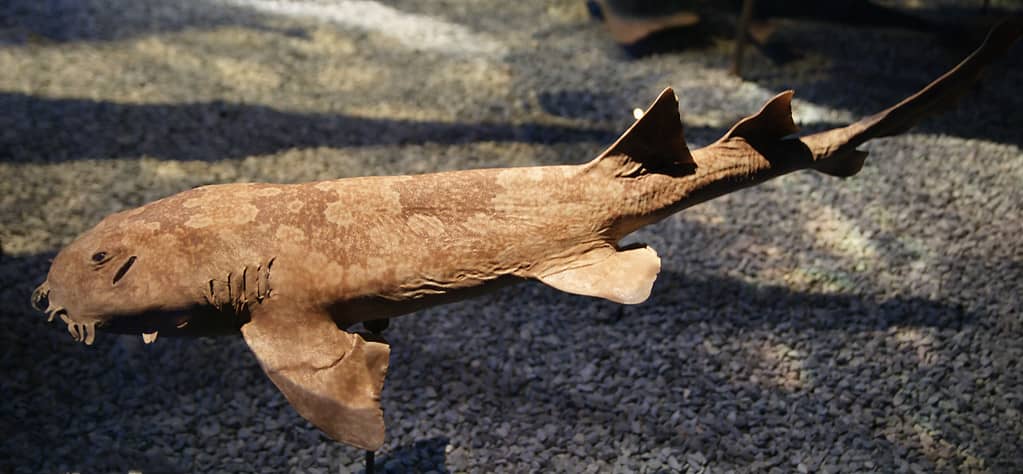
Japanese wobbegong (
Orectolobus japonicus) is a strange variety of deepsea sharks.
©Sandstein / CC BY 3.0 – License
Appearance: The sharks are a bit unsharklike with their strange faces. They have a broad flat head, long flat body, and a long tail.
Size: 3 – 3.3 feet long
Conservation Status: Threatened due to fishing.
These sharks are also sometimes referred to as carpet sharks. They spend most of their time just off the shore in the sandy or gravelly sandbar. The wobbegong sharks sometimes lay on the bottom of the seabed up to 650 feet down, where they spend the day sleeping to prepare for an active night hunting prey. They are bottom feeders who swim along the seabed, eating small invertebrates, shark egg cases, and shrimp.
The small sharks give birth to live pups after a gestation period of 12 months. Typically, there can be 27 pups born at one time, and they survive in the womb by eating the yolk of the eggs.
2. Scalloped Hammerhead Shark (Sphyrna lewini)

Hammerhead sharks
have a unique visual advantage over all other sharks.
©Ian Scott/Shutterstock.com
Appearance: Large share with hammer-shaped double-sided head with an eye at each end. There is a central indentation along with grooves along the anterior margin of the hammer, making this hammerhead slightly different than the great hammerhead shark.
Size: 9 – 14 feet long, with females being larger than males.
Conservation Status: Endangered
The moderately aggressive scalloped hammerhead shark is commonly found alone, in pairs, and also in schools of other hammerheads. This is especially true for females. They join these schools of larger, older hammerhead sharks until they reach maturity. At the center of the schools are older “matriarch” hammerheads and along the outside swim the younger juvenile sharks. Females do not reach maturity until they are 15 – 17 years old.
A male reaches maturity at approximately six years old. They will brave the circle of females when he has matured and is on the hunt for a mate. Once the hammerheads have mated, the female’s gestation period will range from 8 – 12 months. She will have somewhere between 12 to 41 pups, who will be on their own once they have entered the ocean water.
3. Japanese Angel Shark (Squatina japonica)

The Japanese angel shark is closely related to the Taiwanese and Indonesian angel shark.
©LuisMiguelEstevez/Shutterstock.com
Appearance: The Japanese angel shark is flat and camouflaged to blend in with the sandy seafloor. They have pectoral and pelvic fins that look like wings, similar to stingrays. The angelshark has 10 rows of sharp, pointed teeth.
Size: 5 – 8.5 feet long.
Conservation Status: Vulnerable
These strange, peaceful sharks can be found as deep as 1000 feet beneath the ocean’s surface. They are true bottom dwellers that live on the seabed and rarely leave except to seek food in a different location. These ambush predators lay still on the ocean floor and wait for prey to come to them. They launch out of their hiding spot and grab their victim. Their diet consists of squid, crustaceans, and small fish. Traditionally, the angel shark has been hunted for its skin, which is similar to leather and is called shagreen. They are also sought for their meat.
4. Sandbar Shark (Carcharhinus plumbeus)
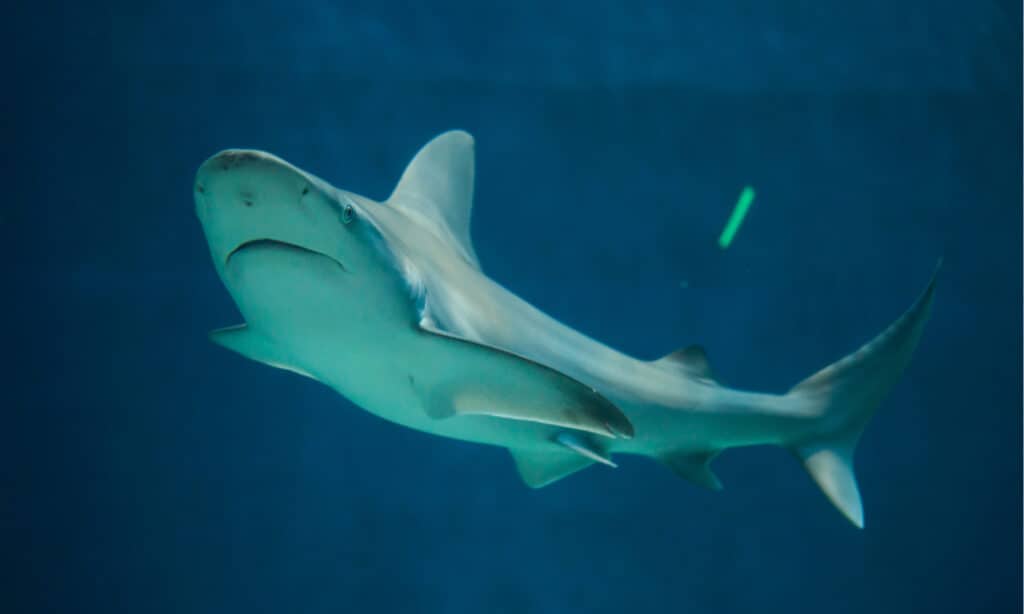
The sandbar shark is a popular type of shark for aquariums.
©Vladimir Wrangel/Shutterstock.com
Appearance: Sleek and rough-skinned shark with long, rounded snouts. They can be blueish, grey, or bronze with a white underside. The sandbar shark has long pectoral fins and pointed serrated teeth. The skin on the females is much thicker than that of the males, likely due to the bites inflicted upon females by males.
Size: 5.5 – 8.5 feet long. The females reach maturity at 13 years old and are typically five feet long. Their fully grown size is an average of slightly over eight feet long. The males reach maturity one year earlier and are roughly the same size as the females. When they are fully grown, they will reach an average of just under six feet long.
Conservation Status: Vulnerable
The sandbar shark avoids beaches, surf, and areas where the water is turbulent. Instead, they prefer the calmer waters of bays, inlets, and river mouths in harbors. These sharks are not aggressive and live off a diet of crustaceans when they are young and other sharks, bony fish, shrimp, rays, and cephalopods once they have matured. The sharks are prey to tiger sharks and occasionally great white sharks.
In February and April, the female sandbar shark will give birth to up to 14 pups after having a 12-month gestation period. Funny how we humans think of nine months as being an excruciating amount of time to carry a child. Imagine carrying 14 for 12 months!
5. White Spotted Bamboo Shark (Chiloscyllium plagiosum)

It’s hard not to see the small white-spotted bamboo shark as adorable.
©iStock.com/caio acquesta
Appearance: The white-spotted bamboo shark is camouflaged to blend in with the sandy seabed. This carpet shark is covered in white spots and has dark bands or saddles down their long, thin bodies.
Size: 2 – 3 feet long. Males grow to 1.5 – 2.5 feet, whereas the females grow to 3 – 3.5 feet long. When they are newborns, the sharks are only four or five inches long. They reach two feet long before maturing.
Conservation Status: Threatened
The white spotted bamboo shark is a small bottom-dwelling reef shark that is commonly preyed upon by larger sharks, fish, and marine mammals. The sharks typically eat crustaceans, invertebrates, and small fish. They are commonly found inshore along the sandy bottom or among reefs. As nocturnal sharks, they spend their days sleeping among reef crevices. They are also popular aquarium sharks but require at least 100 gallons to live in.
6. Japanese Bullhead Shark (Heterodontus japonicus)
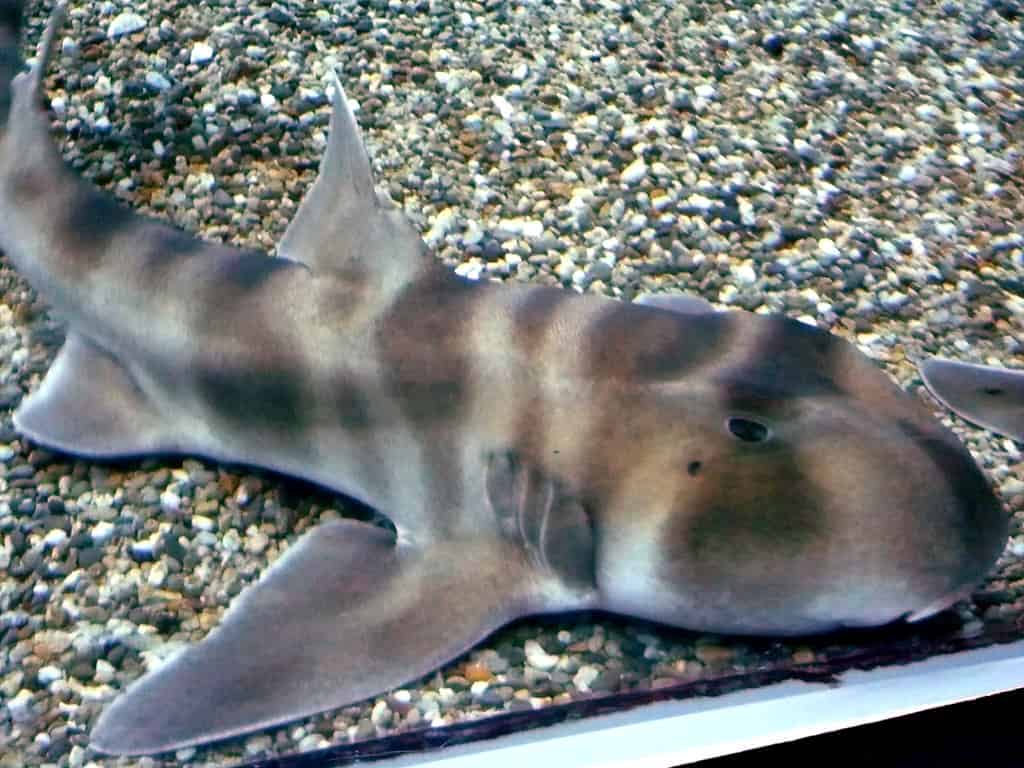
Japanese bullhead sharks (
Heterodontus japonicus) use a motion similar to walking along the sea floor when looking for prey.
©Jennifer Feuchter from Surrey, Canada / CC BY 2.0 – License
Appearance: Large-headed sharks with long, narrow bodies. It has many dark bands or saddles covering its body, with the other coloring being tan and white. The head of the shark is square and has prominent ridges above the eyes. They have two high dorsal fins, with all fins seemingly unmarked. They appear to be camouflaged to blend in with the sea floor.
Size: 3.8 – 4 feet long
Conservation Status: Least Concern
The rather cute bullhead shark has small, sharp front teeth with flat back teeth. They swim along the sea floor, eating crustaceans, mollusks, small fish, and sea urchins. The motion used to search for prey is similar to walking as they use their pectoral and pelvic fins to navigate the bottom. They have protractable jaws used to catch their prey. The sharks can be found at depths of 20 – 120 feet beneath the surface. They enjoy rocky areas in kelp or reefs where they can stay hidden from larger predators.
7. Pelagic Thresher Shark (Alopias pelagicus)

Pelagic thresher sharks are unique-looking with their rounded snouts and long fins.
©Shane Gross/Shutterstock.com
Appearance: The pelagic thresher shark has a rounded snout, huge eyes, and a very long upper lobe caudal fin. The super long upper tail fin is used to stun prey to make it easier to catch. The sharks are bluish-grey with a white underside to blend in with the surface and sea better.
Size: 10 – 13 feet long
Conservation Status: Vulnerable
The thresher sharks’ meat and fins are considered a delicacy in some cultures, and their skin is used as a type of leather. Traditionally, their large livers were used to make cosmetics, health food, and high-grade machine oil.
The pelagic thresher sharks can use their circulatory system to heat their bodies in colder waters. They can be found anywhere from the surface of the ocean down to 500 feet down. It is not known what the sharks do at night. They may dive deeper than 500 feet or spend more time in the open ocean.
8. Zebra Shark (Stegostoma Fasciatum)
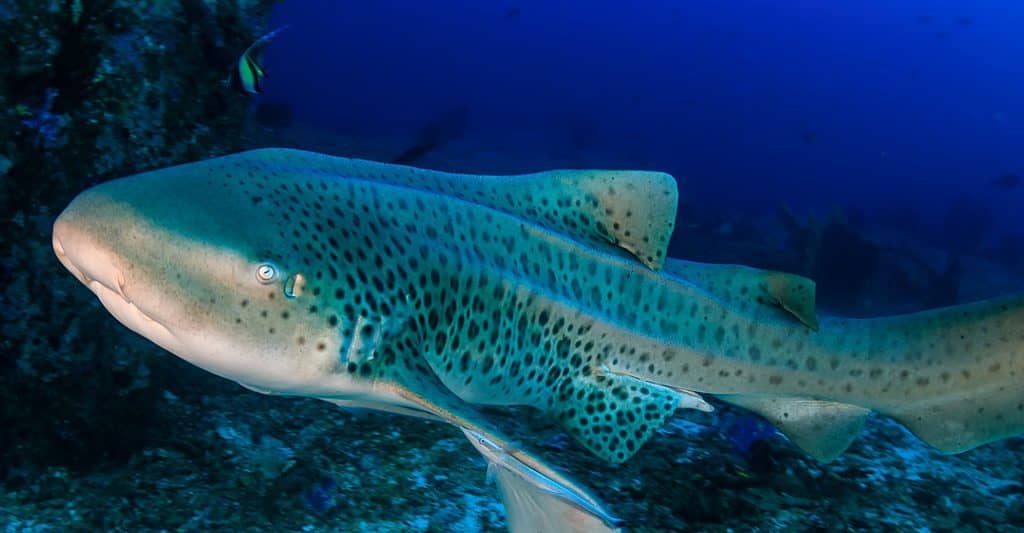
Zebra sharks are striped when they are juveniles, with their stripes turning to spots as they age.
©iStock.com/WhitcombeRD
Appearance: The zebra shark is a sandy brown-colored shark with plenty of darker brown spots covering its body. When the sharks are still juveniles, their spots are still yellowish stripes on a dark brown body, giving them their name. As they mature, the stripes disappear. They are often confused with leopard sharks because of this.
Size: 8.2 – 13 feet long, with their tails taking up half of their length.
Conservation Status: Vulnerable. They are hunted for their fins used in Chinese shark fin soup.
The adorable zebra shark is a type of carpet shark and is not aggressive towards humans. They choose to stay among coral reefs and sandy or grave bottoms where the water is calm. They can swim into tight places like small caves to find prey. The sharks eat snails, crabs, small fish, invertebrates, and sea urchins. Their large mouths contain powerful suction that allows them to suck up their prey in one gulp. As a nocturnal shark, the zebra shark rests on the ocean floor during daylight hours. The zebra shark is also capable of living in brackish or freshwater.
9. Tawny Nurse Shark (Nebrius ferrugineus)

Tawny Nurse Shark (
Nebrius ferrugineus) sleeps in a pile with other nurse sharks during the day to keep each other warm and provide protection.
©Nigel Marsh/iStock via Getty Images
Appearance: Light brown to grey coloring that can change slowly to match their environment. They have long barbels, which help them feel for prey along the ocean floor. Their caudal fin is very long and makes up a quarter of their overall length.
Size: 9.6 – 11 feet long
Conservation Status: Vulnerable
The tawny nurse shark prefers fairly shallow water in protected areas like coral reef caves, lagoons, channels, and rocky reef edges. They typically stay in depths ranging from 17 – 100 feet. They are nocturnal and spend their nights searching for prey among reeds. During the day, the sharks can be witnessed sleeping in a pile or near one another for protection. They are fairly harmless but may bite if harassed or stepped on during the day. They also spit water at people who catch them on fishing lines.
These are the only species of carpet shark with intrauterine cannibalism among pups. They give birth to 1 – 4 pups depending on who survives and who is eaten. They have large, infertile eggs to eat, but some compete for food based on size, and the smaller shark will be eaten.
10. Whale Shark (Rhincodon Typus)

The whale shark is one of the most popular shark species to swim with during their time spent in coastal areas.
©Aaronejbull87/Shutterstock.com
Appearance: Amazingly beautiful, long, broad-bodied shark. They have white or bluish-white spots over their bluish-grey to charcoal-grey coloring. Along their sides are lines alongside the white spots. Their snouts are as broad as their heads and open to show an enormous mouth. The whale sharks typically swim near the surface with their mouths open to filter out the seawater and collect tiny plankton.
Size: 20 – 40 feet long and weigh 11 tons! The largest on record was 61.7 feet long.
Conservation Status: Endangered
The migratory gentle giant, the whale shark, is one of the most beloved oceanic creatures. People pay a lot of money for the chance to swim with them while they are congregating off coastal shores in warm waters. They also spend a large amount of time alone in the open ocean. It is not known when whale shark pups are born or where they mature. Documentation of a whale shark’s birth or pups has never been recorded. Whale sharks may have up to 300 pups at one time.
11. Oceanic Whitetip Shark (Carcharhinus longimanus)
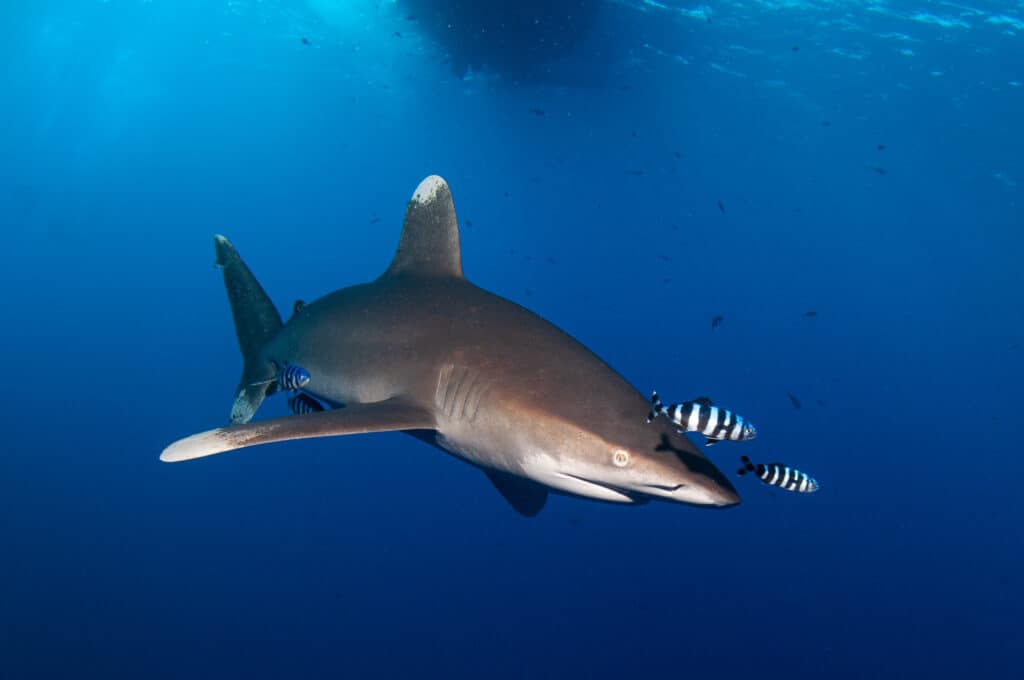
The oceanic whitetip shark is dangerous when you are stranded in the open ocean.
©MartinRejzek/Shutterstock.com
Appearance: Very large, stocky sharks with muscular builds. They can be a bluish-grey, grey-brown, or bronze color with a white underside with the tips of their fins mottled white. They have been recorded diving as deep as 3,500 feet beneath the ocean surface.
Size: 10 – 13 feet long
Conservation Status: Threatened
These sharks are opportunistic hunters and will eat pretty much anything that comes their way. Sometimes, they even eat trash, which will kill them. They eat dolphins, other sharks, tuna, marlin, and cephalopods. Unlike most of the other sharks in Japanese waters, the whitetip shark is highly aggressive towards humans. It has been responsible for many attacks on people stranded at sea. It’s hard to blame them since, at that point, we are way out of their home and far from where we belong.
Some people, such as Jacques Cousteau, have referred to the whitetip shark as the most aggressive and dangerous of all sharks. It’s tough to pick a side since sharks are animals behaving exactly as they should to survive. When we choose to enter the ocean, we are signing a nonnegotiable contract stating that we understand the risks and are open to taking our chances. Considering the horrors we inflict upon sharks, it’s us who are the dangerous ones, not them. After all, they have a prime ingredient in the endangered-species-rendering shark fin soup widely enjoyed in Asia as a delicacy.
12. Longfin Mako Shark (Isurus paucus)
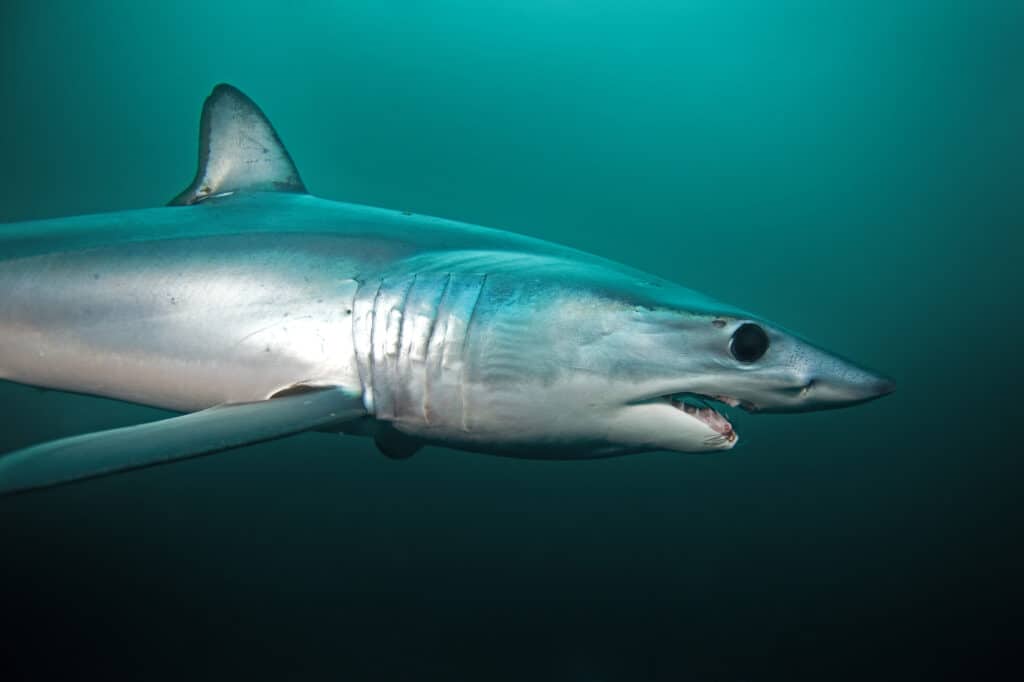
The Longfin Mako shark is a very large species of shark that can grow to around 14 feet.
©Martin Prochazkacz/Shutterstock.com
Appearance: These long, muscular sharks have cone-shaped noses and spear-shaped bodies. They look similar to great white sharks, which are close cousins to the mako. The longfin mako does indeed have very long pectoral fins, which slow them down a bit. They help them stay afloat, and since their lives depend on it, they must always remain swimming to pump air through their lungs.
Size: 12 – 14 feet long
Conservation Status: Vulnerable
Mako sharks, as a whole, are classified as very aggressive. This means there have been unprovoked attacks, though none have been recorded as the longfin mako. The longfin mako is not common like its cousin, the shortfin mako, and is rarely spotted. They are also fast sharks who sprint up to 30 mph, which is quite the feat underwater. Some of the other types of mako can swim up to 45 mph!
13. Basking Shark (Cetorhinus maximus)

Basking sharks (
Cetorhinusmaximus) are amazing and gentle giants of the sea, often seen on cruise ships.
©rossbeane, CC BY-SA 2.0, via Wikimedia Commons – License
Appearance: Very large, big-nosed sharks with very large mouths. They have extra sets of gills for water and prey filtration. They are dark charcoal grey or sometimes a brownish grey on the upper and lighter or sometimes nearly white on the underside.
Size: 23 – 30 feet long; the largest recorded was nearly 40.3 feet long and weighed 18 tons! The basking sharks are even larger at birth and measure 5 – 6 feet long. They may be as long as 20 feet before reaching maturity.
Conservation Status: Endangered. The Chinese and Japanese still hunt them for their livers and fins.
The large, harmless, peaceful giants are filter feeders, meaning they feast on very small creatures floating near the surface of the ocean to let ocean water (and prey) filter through their large mouths, and the water then filters back out into the ocean through their gills. The baking shark is the only shark that relies on the flow of water pushed through its pharynx through swimming. It is then able to eat the zooplankton it needs to stay alive.
14. Blue Shark (Prionace glauca)
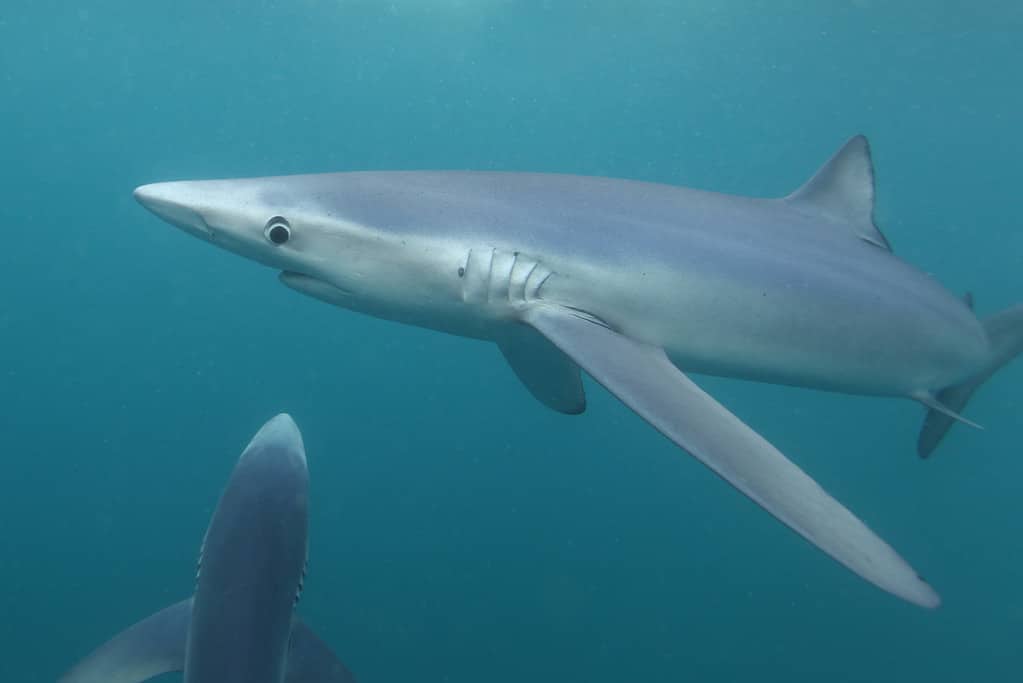
Blue sharks are very curious sharks and approach divers and fishing boats.
©Alessandro De Maddalena/ via Getty Images
Appearance: The blue shark is a very sleek, lean, spear-shaped shark that often appears blue. They have a very long pointy snout and large eyes. They have very long pectoral fins.
Size: 6 – 11 feet long
Conservation Status: Near threatened
The blue shark is not afraid of people and has a very curious nature, which deserves respect. They have been known to attack people stranded in the open ocean, but what pelagic shark wouldn’t at least take a test bite?
The sharks prefer cooler water and will dive down if the water they are in is too warm. They will dive as deep as 1200 feet below the surface.
15. Banded Houndshark (Triakis scyllium)
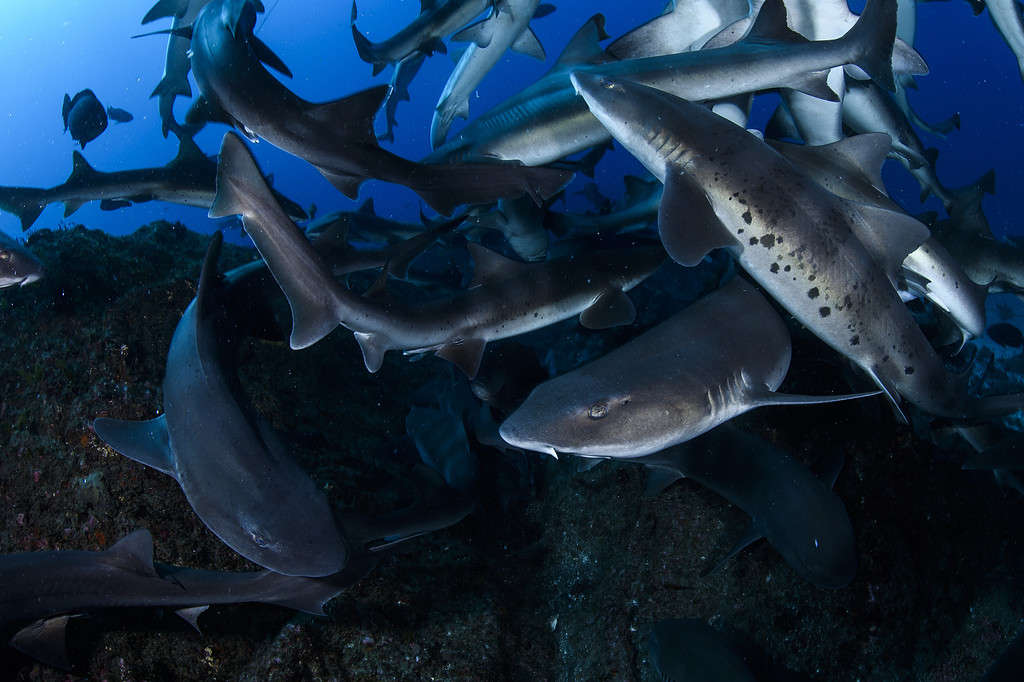
Banded houndsharks are generally solitary animals, but when food is plentiful, they can become more of a team player.
©Martin Voeller/iStock via Getty Images
Appearance: The banded houndshark is a long slender-bodied shark with a long tail or bottom caudal fin. They have short, rounded snouts with wide spacing between the nostrils. The eyes are located on top of the head.
Size: 3.4 – 3.8 feet long. The largest banded hound shark on record was 4.9 feet.
Conservation Status: Endangered
The banded hound shark is another popular shark for large home aquariums. In the wild, they can sometimes swim along the seafloor from 100 – 500 feet down. They also sometimes enter estuaries looking for food. They eat a variety of crustaceans, spoonworms, small bony fish, and cephalopods. The larger sharks focus on cephalopods.
The photo featured at the top of this post is © Martin Prochazkacz/Shutterstock.com
Thank you for reading! Have some feedback for us? Contact the AZ Animals editorial team.







